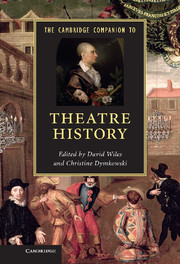12 - The art of acting
from Part IV - What?
Published online by Cambridge University Press: 05 February 2013
Summary
‘an awareness of history. . .’
How can we construct a history of the art of acting? Acting is an evanescent art form that leaves few visual traces behind, while the creative work leading up to a performance is soon effaced from memory. What approach should we adopt in order to trace the evolution of the actor’s art? Should we study key dates, or should we instead concentrate on the talent of particular actors whose art assumed a distinctive form?
The history of performance can be written in different ways, depending on which of these two approaches is chosen. In the first, the sum total of past events generates a developmental sequence that today we dismiss as a utopian vision – merely the reflection of the researcher’s selective gaze upon moments that have been privileged over other moments. In the second approach, focusing on individual artists and their performance skills, the picture seems to disintegrate, since an impressionistic overview, brought into close-up, cannot capture the overall reality of an art.
Beyond this fundamental question about how to create the history of the actor’s art lies a much more crucial question – one that arises in critical discourse and in acting schools – concerning the very necessity of this history. Can a better understanding of history really shed light on the present of a theatre characterised by its urgent need to get on with the show, to illuminate the text, or to stage a collective work? These questions are fundamental to any historical inquiry. They are questions that the historians of the ‘Annales’ School addressed by creating a history of ideas and attitudes rather than a history of facts and events, a history that places events in their contexts and geographic settings and, crucially, examines the bearing these events have on the present. In what follows, my thoughts will be guided by the responses of three directors to the question ‘What place do you accord to history?’ These directors are Jacques Delcuvellerie, Jerzy Grotowski and Antoine Vitez.
- Type
- Chapter
- Information
- The Cambridge Companion to Theatre History , pp. 184 - 196Publisher: Cambridge University PressPrint publication year: 2012

